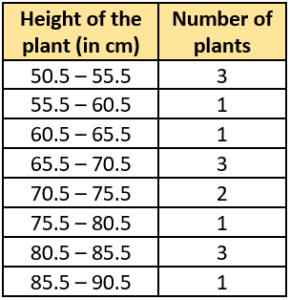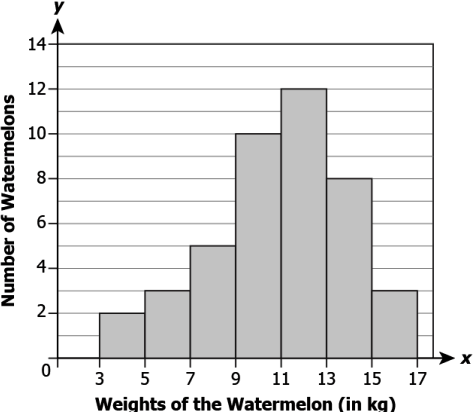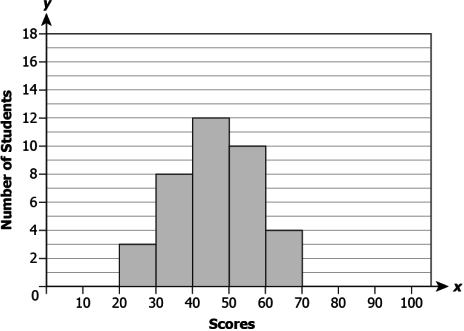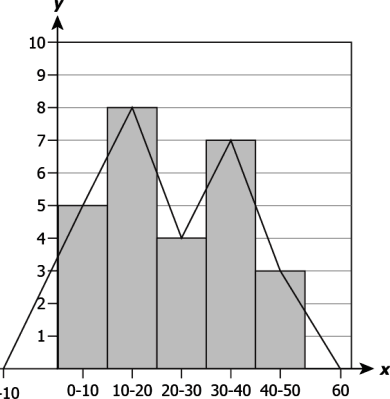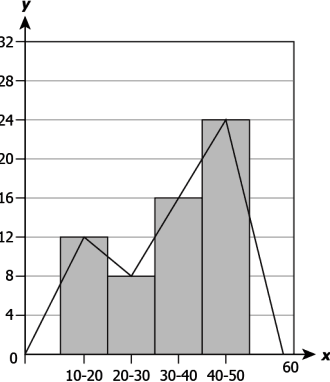Hint: Record and label a given data set in order to create a frequency table.
Question.1. Vinod records the ages (in years) of people in a central park as shown below.
7, 12, 18, 16, 6, 9, 11, 21, 24, 35, 38, 52, 58, 60, 45, 55, 8, 10, 15, 12, 39, 44, 10, 5, 19, 31, 29, 48, 50, 16.
Which of the frequency tables correctly represents the data with a class size of 8?
(a) 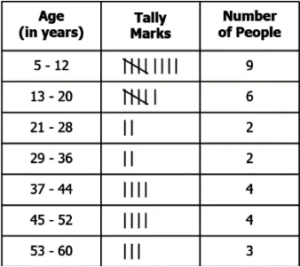
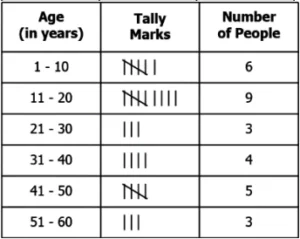

Question.2. Riya measured the heights of the plants in her backyard and recorded the data as shown below.
58.5 cm, 62 cm, 68.1 cm, 52.3 cm, 81.6 cm, 72.5 cm, 69.5 cm, 70.5 cm, 54.1 cm, 55.5 cm, 85.5 cm, 78.3 cm, 82.9 cm, 74.2 cm, 86 cm
She then incorrectly created a frequency table of the data collected as shown below.
Which of these could be the possible reason of error in Riya’s frequency table?
(a) 70.5 cm and 85.5 cm must be considered in class (70.5 – 75.5) and class (85.5 – 90.5) respectively, and not in class (65.5 – 70.5) and class (80.5 – 85.5).
(b) 70.5 cm and 85.5 cm must be considered in class (65.5 – 70.5), class (50.5 – 55.5), and class (80.5 – 85.5) respectively, and not in class (70.5 – 75.5) and class (85.5 – 90.5).
(c) 70.5 cm, 55.5 cm, 85.5 cm must be considered in class (70.5 – 75.5), class (55.5 – 60.5), and class (85.5 – 90.5) respectively, and not in class (65.5 – 70.5), class (50.5 – 55.5), and class (80.5 – 85.5).
(d) 70.5 cm, 55.5 cm, 85.5 cm must be considered in class (65.5 – 70.5), class (50.5 – 55.5), and class (80.5 – 85.5) respectively, and not in class (70.5 – 75.5), class (55.5 – 60.5), and class (85.5 – 90.5).
Ans.1. (c)
Hint: Identify an appropriate scale and labels in order to represent given data through a bar graph.
Question.3. A student recorded the population of some villages as shown below.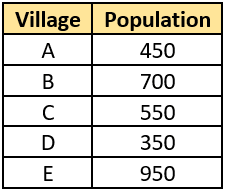
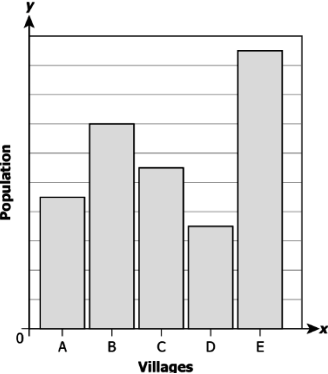
(a) 1 unit = 10 people
(b) 1 unit = 50 people
(c) 1 unit = 100 people
(d) 1 unit = 500 people
Question.4. The bar graph below shows the number of students residing at different hostel buildings in a university.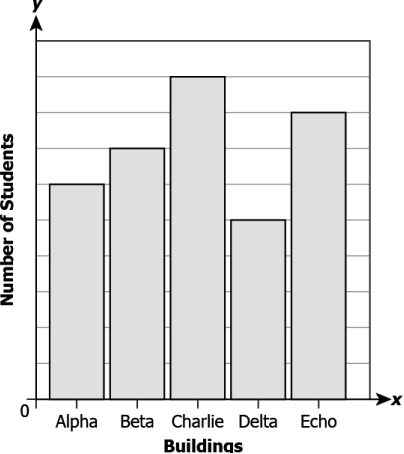
(a) 90
(b) 135
(c) 180
(d) 225
Ans.3. (c) 1 unit = 100 people
Ans.4. (c) 180
Hint: Read a given bar graph in order to infer a variety of information from it.
Question.5. The bar graph below shows the number of sea animals in a large aquarium.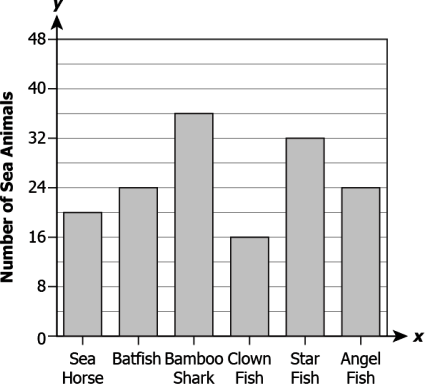
(a) 2
(b) 4
(c) 6
(d) 8
Question.6. The bar graph shows the annual income of a group of friends.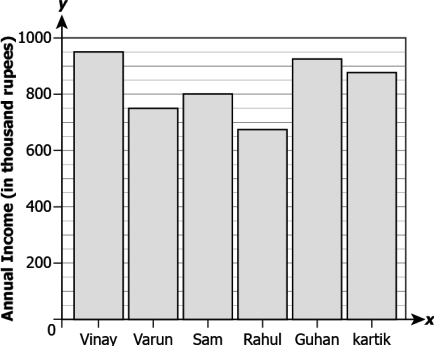
(a) Vinay; Rs 200000
(b) Vinay; Rs 275000
(c) Guhan; Rs 175000
(d) Guhan; Rs 250000
Ans.5. (b) 4
Ans.6. (b) Vinay; Rs 275000
Hint: Read the given data in order to create a histogram for continuous and discontinuous data sets.
Question.7. The table below show the weights of watermelons at a store.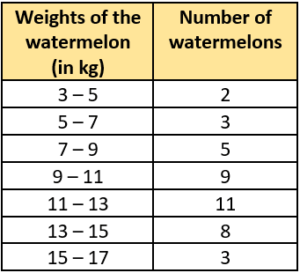
(a) 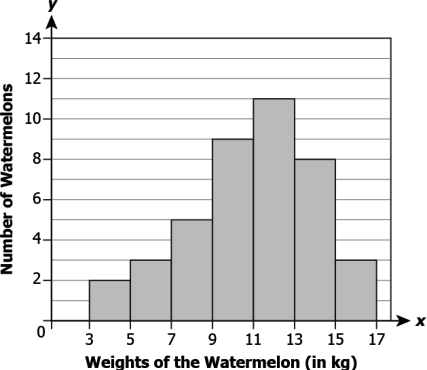
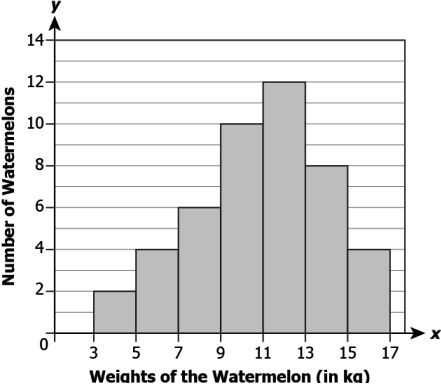
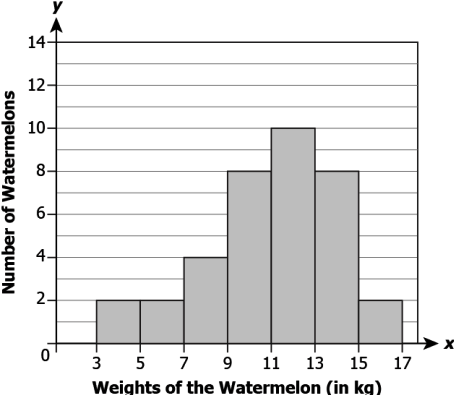
Question.8. The table below shows the quiz scores of a class of students.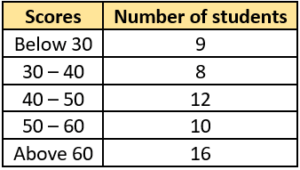
(a) 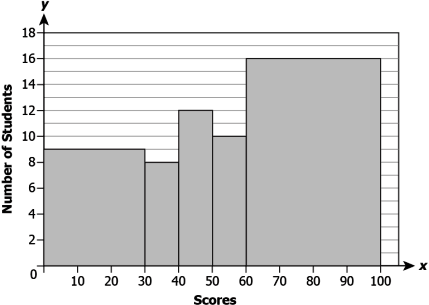
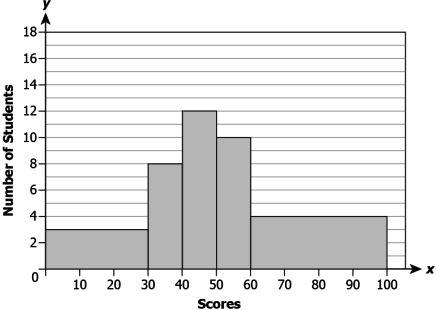
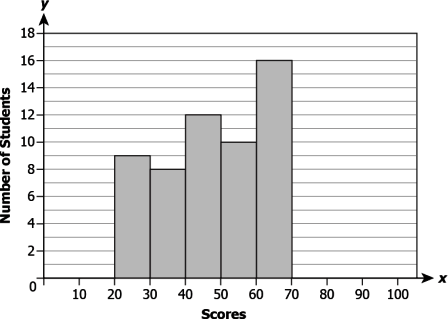
Ans.7. (a) 
Hint: Read a given histogram in order to infer a variety of information from it.
Question.9. The histogram below shows the number of visitors in a museum on different number of days: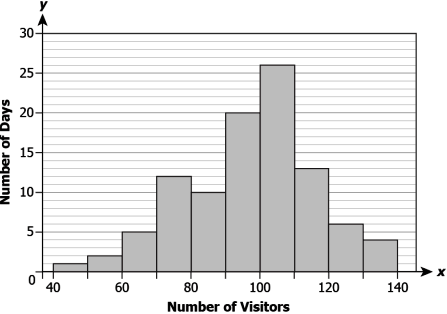
(a) There were about 80-90 visitors for 12 days at the museum.
(b) There were about 60-70 visitors for 5 days at the museum.
(c) There were about 120-140 visitors for 6 days at the museum.
(d) There were about 100-120 visitors for 26 days at the museum.
Question.10. The histogram below shows the daily commute time, in minutes, for 18 employees of an office.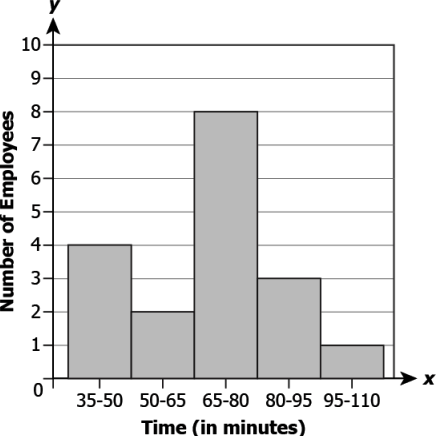
(a) 4 employees take 35-50 minutes to commute to office.
(b) 8 employees take 65-95 minutes to commute to office.
(c) 6 employees take less than 65 minutes to commute to office.
(d) 4 employees take more than 80 minutes to commute to office.
Ans.9. (b) There were about 60-70 visitors for 5 days at the museum.
Ans.10. (b) 8 employees take 65-95 minutes to commute to office.
Hint: Read the given data in order to create a frequency polygon for given data sets.
Question.11. Consider the data set shown below: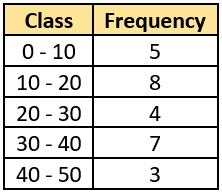
(a) 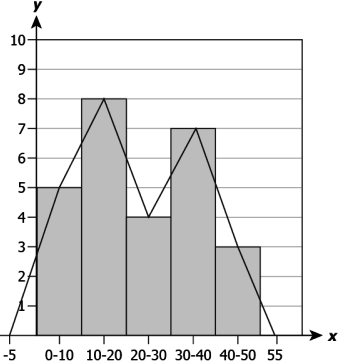
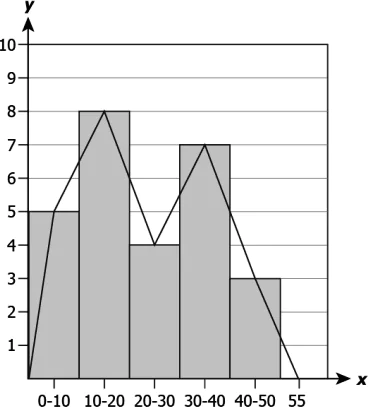
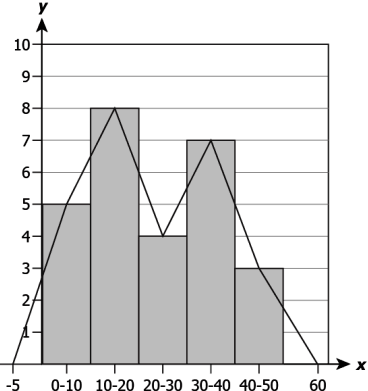
Question.12. The table below shows the points scored by 60 players.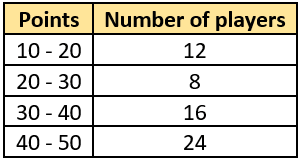
(a) 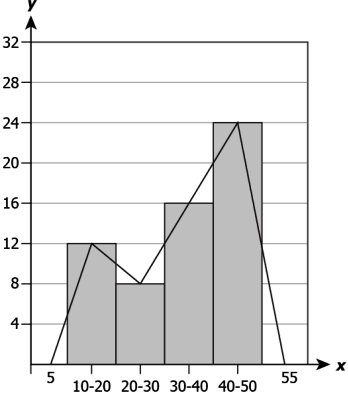
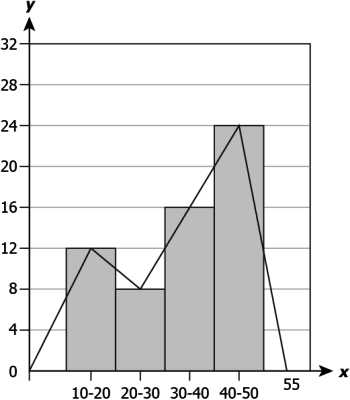
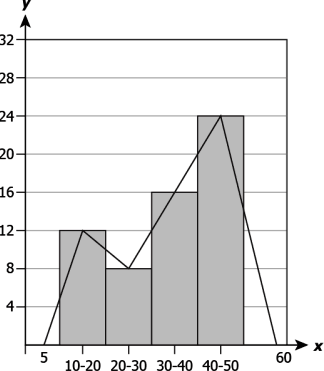
Ans.11. (a) 
Hint: Read a given frequency polygon in order to infer a variety of information from it.
Question.13. The frequency polygon below shows the time, in seconds, taken by 24 students of a class to complete a 100-m dash.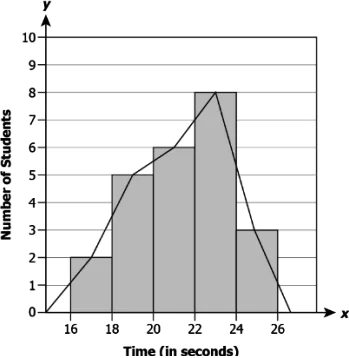
(a) 11 students took 22 or more minutes to complete the 100 m dash.
(b) 2 students took 16-18 seconds to complete the 100 m dash.
(c) 7 students took 16-20 seconds to complete the 100 m dash.
(d) 8 students took 22-26 seconds to complete the 100 m dash.
Question.14. The frequency polygon below shows the amount, in cm, of rainfall received on different number of days in a city over a year.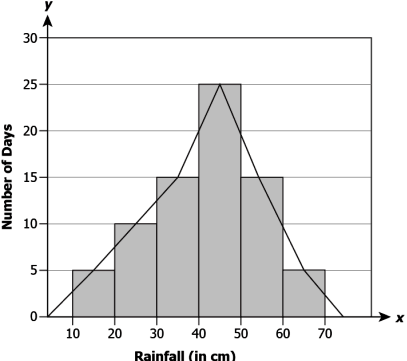
(a) The maximum amount of rainfall received is between 40-50 cm.
(b) The amount of rainfall received was about 10-20 cm for 10 of the days.
(c) The amount of rainfall received was about 50-60 cm for more than 15 of the days.
(d) There were equal number of days when the rainfall was between 10-20 cm and 60-70 cm.
Ans.13. (d) 8 students took 22-26 seconds to complete the 100 m dash.
Ans.14. (d) There were equal number of days when the rainfall was between 10-20 cm and 60-70 cm.
Hint: Differentiate between mean, median and mode with examples in order to understand most effective measure of central tendency in various cases.
Question.15. The amount of snowfall received over two weeks in a city is listed below.
2 cm, 3 cm, 6 cm, 2 cm, 4 cm, 3 cm, 12 cm, 5 cm, 1 cm, 3 cm, 4 cm, 3 cm, 2 cm, 6 cm
Which of the following is the most effective measure of central tendency?
(a) Mean because the data has extreme data points.
(b) Median because the data has extreme data points.
(c) Mean because the data has no extreme data points.
(d) Median because the data has no extreme data points.
Question.16. There are 16 students in a dance class. The age of the students (in years) are shown below.
12, 14, 18, 20, 11, 13, 22, 24, 14, 19, 20, 16, 12, 14, 20, 15.
If two more students of age 10 and 14 years join the class, which statement is true about the central tendency of the data?
(a) The central tendency of the data decreases by 1 as the mean decreases by 1.
(b) The central tendency of the data decreases by 1 as the median decreases by 1.
(c) The central tendency of the data decreases by 0.5 as the mean decreases by 0.5.
(d) The central tendency of the data decreases by 0.5 as the median decreases by 0.5.
Ans.15. (b) Median because the data has extreme data points.
Ans.16. (c) The central tendency of the data decreases by 0.5 as the mean decreases by 0.5.
Hint: Apply appropriate formula in order to calculate the mean and median of even and odd number of data points.
Question.17. What is the mean and median of the data set shown below?
10, 5, 6, 2, 11, 13, 5, 8, 3
(a) Mean: 7; Median: 5
(b) Mean: 7; Median: 6
(c) Mean: 6; Median: 7
(d) Mean: 6; Median: 6
Question.18. The data set below shows the time, in minutes, taken by 10 students to solve a mathematics problem.
2, 5, 8, 4, 4, 3, 6, 2, 11, 5
What is the mean and median of the time taken?
(a) The mean time is 5 minutes and the median time is 4.5 minutes.
(b) The mean time is 4.5 minutes and the median time is 5 minutes.
(c) The mean time is 5 minutes and the median time is 4 minutes.
(d) The mean time is 4 minutes and the median time is 5 minutes.
Ans.17. (b) Mean: 7; Median: 6
Ans.18. (a) The mean time is 5 minutes and the median time is 4.5 minutes.
Hint: Recall and use the formula for mean in order find the value of a missing observation.
Question.19. Consider the data set shown below.
12, x, 10, 4, 7, 8, 7, 5
If the mean of the given data set is 7, what is the value of x?
(a) 3
(b) 4
(c) 7
(d) 10
Question.20. In the table below, the grocery expenditure of 2 months of a family is missing.
(a) The family spend ₹3800 in May and ₹1900 in June.
(b) The family spend ₹1900 in May and ₹3800 in June.
(c) The family spend ₹3800 in May and ₹7600 in June.
(d) The family spend ₹1900 in May and ₹950 in June.
Ans.19. (a) 3
Ans.20. (a) The family spend ₹3800 in May and ₹1900 in June.



